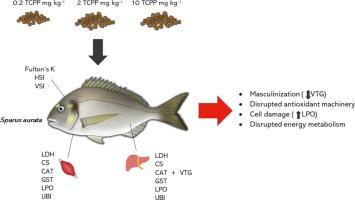海洋鱼类对有机磷阻燃剂三(2-氯异丙基)磷酸(TCPP)膳食暴露的生态毒理学反应:以幼鱼(Sparus aurata)为例
IF 4.9
3区 环境科学与生态学
Q1 ENVIRONMENTAL SCIENCES
引用次数: 0
摘要
高产量化学品(HPVCs)是对水生环境和水生物种构成严重威胁的污染物,因为它们的大规模生产和在生物隔间中的普遍分布。其中,有机磷酸酯(OPEs)尤其令人关注,因为它们被广泛用作增塑剂和阻燃剂,并与海洋生物中各种形式的毒性有关。在这项研究中,我们研究了幼鱼幼鱼对2-氯异丙基磷酸盐(2-氯异丙基)在三种不同浓度(低浓度D1: 0.2 mg kg−1;生态相关,D2: 2 mg kg−1;高D3: 10 mg kg−1)。分析了肝脏和肌肉中指示抗氧化防御机制的不同生物标志物(过氧化氢酶,CAT,谷胱甘肽s -转移酶,GST,活性),代谢(柠檬酸合成酶,CS,乳酸脱氢酶,LDH,活性)和内分泌干扰(卵黄蛋白原含量,VTG),以及细胞(脂质过氧化水平,LPO)和蛋白质损伤(泛素含量,UBI),以评估TCPP毒性。高浓度的TCPP对金盏花生长有影响,但对整体适应状况没有影响。此外,无论暴露剂量如何,都观察到代谢紊乱和严重的氧化损伤。暴露于所有TCPP剂量后,VTG含量显著降低,表明可能的男性化效应。这些发现对TCPP的生态毒理学特性及其对海洋鱼类的影响提供了新的科学认识。此外,我们的研究结果证实了开展综合多生物标志物方法的相关性,以揭示研究较少的化学污染物的生态毒理学效应,并最终实施废水处理策略和立法,以保护海洋生态系统免受污染。本文章由计算机程序翻译,如有差异,请以英文原文为准。

Ecotoxicological responses of marine fish to the organophosphate flame-retardant tris (2-chloroisopropyl) phosphate (TCPP) dietary exposure: Juvenile gilthead seabream (Sparus aurata) as a case study
High Production Volume Chemicals (HPVCs) are contaminants that pose serious threats to aquatic environments and species that inhabit them, given their massive production and ubiquitous distribution across biological compartments. Among them, organophosphate esters (OPEs) are of particular concern, as they are widely used as plasticizers and flame-retardants, and linked to various forms of toxicity in marine organisms. In this study, we investigated the ecotoxicological response of juvenile gilthead seabream Sparus aurata to the OPE tris (2-chloroisopropyl) phosphate (TCPP) following chronic dietary exposure to three different concentrations (low, D1: 0.2 mg kg−1; ecologically relevant, D2: 2 mg kg−1; and high, D3: 10 mg kg−1). Different biomarkers indicative of antioxidant defence mechanisms (catalase, CAT, glutathione S-transferase, GST, activities), metabolism (citrate synthase, CS, lactate dehydrogenase, LDH, activities) and endocrine disruption (vitellogenin content, VTG), as well as cell (lipid peroxidation levels, LPO) and protein damage (ubiquitin content, UBI) were analyzed in liver and muscle to assess TCPP toxicity. High concentrations of TCPP affected S. aurata growth, but not overall fitness condition. Furthermore, metabolic disruption and severe oxidative damages were observed, regardless of exposure dose. VTG content significantly decreased after exposure to all TCPP dosages, indicating a possible masculinization effect. These findings provide new insights to the scientific knowledge on TCPP ecotoxicological attributes and impacts on marine ichthyofauna. In addition, our results confirm the relevance of conducting integrated multi-biomarker approaches to disclose the ecotoxicological effects of poorly studied chemical contaminants and, ultimately, implement wastewater treatment strategies and legislation to protect marine ecosystems from pollution.
求助全文
通过发布文献求助,成功后即可免费获取论文全文。
去求助
来源期刊

Marine pollution bulletin
环境科学-海洋与淡水生物学
CiteScore
10.20
自引率
15.50%
发文量
1077
审稿时长
68 days
期刊介绍:
Marine Pollution Bulletin is concerned with the rational use of maritime and marine resources in estuaries, the seas and oceans, as well as with documenting marine pollution and introducing new forms of measurement and analysis. A wide range of topics are discussed as news, comment, reviews and research reports, not only on effluent disposal and pollution control, but also on the management, economic aspects and protection of the marine environment in general.
 求助内容:
求助内容: 应助结果提醒方式:
应助结果提醒方式:


